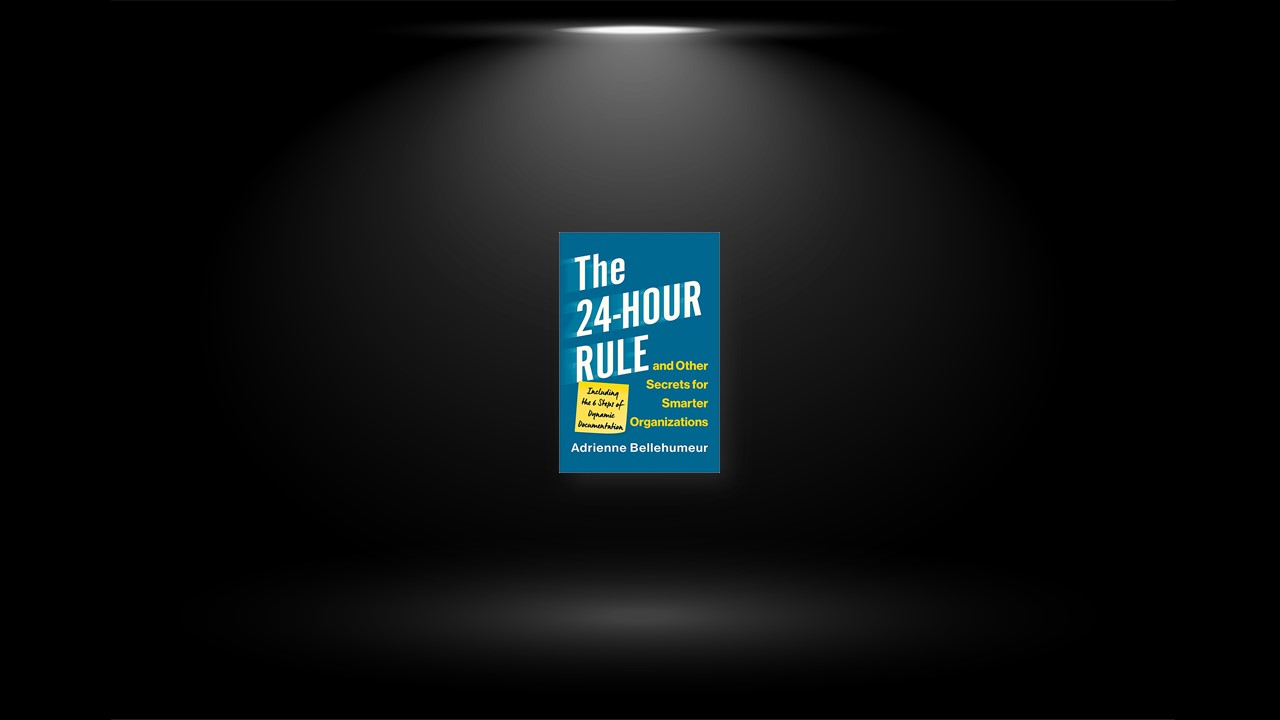What Is Dynamic Documentation and Why Does It Matter?
If we want to work smarter, faster, and better—both solo and as teams—it is the author’s firm belief and experience with hundreds of client projects that we need a way to capture and act on everything on our plates at work and at home. To do this, we must listen to people, take good notes, and turn those conversations into action. We must follow these steps along with simple “rules” consistently.
Dynamic Documentation is a practice that shows us how to transform those unthinking, often mundane tasks into a system that drives momentum. It considers documentation a foundational tool for effective productivity and workflow that boosts the impact of our efforts.
Whether we realize it or not, documentation underpins a lot of what we do every day at work, including meetings, following up, organizing, writing emails, planning projects, writing processes and procedures, and generally pushing forward whatever we are working on.
Capturing
If you want to remember it, document it. Capturing is where the Dynamic Documentation process starts. Think of it as mining for gold, digging for buried treasure, sleuthing for clues, hunting for prey, diving for pearls (or whatever floats your boat or turns your crank).
For some of us, the Capturing phase creates anxiety. Will documenting ideas somehow result in criticism? Will it negatively impact career growth? Maybe it’s better to just “sleep on it” and see how it plays in the morning?
And the reality is: Finding your best pieces of information is a lot like hitting a baseball. You try your best and sometimes you fail. In the world of major league baseball, a batting average of .300 or better is the mark of a toptier hitter. That means, you understand, that this player will fail to get a hit seven out of ten times.
So please capture those nuggets and cultivate ideation. And document, document, document. The pursuit of excellence will sometimes result in a “strike out,” and that’s OK.
The prize you are looking for may come from your own head, someone else’s head, a team meeting, a brainstorming session, a webinar, something you heard on the news, or a conversation around the water cooler. Whatever your source, you need a system—and a habit—for trapping this information so it doesn’t escape. From there, you will tame, train, and polish it to make the magic happen.
Structuring
Build fast, fill in, rinse, repeat.
Form follows function. All the greatest breakthroughs in the world—in science, business, entrepreneurship, technology, and the arts—have come from structuring unstructured information into something beautiful and, ultimately, useful, finding patterns where none had been seen before. You too can create great things from seeing creative patterns in information using Dynamic Documentation.
Now that you have your documentation captured, the “Structure” step is about shuffling, moving, pulling together, and looking for patterns and “magic” in the information you’ve got in front of you.
Gaps in structuring may show up as: •Weak analysis of problems •Inability to create documents from scratch •Inability to design processes or systems •Inability to get started on documents, systems, or projects •Poorly constructed documents •Using the wrong types of documents
These days, we are bombarded with information, surrounded as we are by devices and platforms. It’s like we’re stuck in a video game, fighting information gunfire and dodging distraction booby traps. The good news is that our brains have the ability to filter and structure this information even when it is firing at us. Having this ability and actually doing something about it are two different things, however.
Although it may seem counterintuitive, if you are in a job where you have routine tasks or clearly defined orders, you may not have developed a strong ability to structure information. Unstructured environments are another story. They can be the best teachers to build our “structure chops.” Writing reports, creating products, developing new websites, or even starting new businesses are some of the best examples.
Presenting
Curb appeal sells.
Capturing and structuring are the blueprints, foundation, carpentry, and plumbing of your house. “Presenting” is the paint, landscaping, and interior design. Presenting is what “sells” your valuable information to your team. A proper presentation gives it curb appeal, to continue the real estate metaphor.
A house built upon a flawed foundation won’t hold. But a house isn’t a home without the pizzazz of presentation. A document is no different. Technical information alone won’t make your reader fall in love with it, much less engage with it. You want your audience to accept your information, share it, and use it regularly.
Presenting is about dynamic writing (how the content is expressed) and dynamic design (aesthetic considerations). Once you’ve gotten the core content of your document structured and filled in, you will want to polish your product before it’s presented to a larger group.
You don’t need to be a professional writer and you don’t need to spend years in journalism or design school to improve your material. You don’t even need to create long documents. There are lots of ways to share information, including lists and email, that can still practice the secrets of writers and designers.
You can build your and your team’s skills while combining strengths. Team up with one or more colleagues who are strong in writing, editing, graphics, illustration, or layout to crystallize your materials. And remember, for Dynamic Documentation, the focus is on your message, not on your award-winning literary and graphic design abilities.
Keep your goal in mind. Does the document say what it needs to say in a way that connects with, teaches, and motivates its intended audience? •Clarity Standard: Does my audience understand what I am talking about? Can the audience understand the key concepts quickly without having to reread it? Are they “getting it”? •Engagement Standard: Is the document connecting with my reader? Are the key messages and concepts resonating? Does my reader remember the document and its contents? •Re-Performance Standard: Can my reader perform a task based on the document? Do these steps help them with their jobs? •Use Standard: Do people like this document enough to use it?
Communicating
What gets shared gets put into action.
Why is “Communicating” part of Dynamic Documentation? Because communication makes organizations smarter. And a smart documentation practice radically improves communication. Putting aside all the experts, books, and topics on communication, the definition of communication is, in fact, very simple. Communication refers to: 1.The exchanging of information. 2.A means of connection between people.
Let’s focus on the first part of the definition. Documentation has everything to do with exchanging information. Dynamic Documentation excels at exchanging information with purpose, clarity, and power. Documentation also serves the second definition, since it connects people by getting them to a common understanding and moving them in the same direction.
We could also add a third definition: Communication is about persuasion. Verbal skills and the confidence to deliver messages convincingly are critical for being a good communicator. Documentation is an overlooked part of communications in the corporate world. Documentation allows you to communicate your thoughts even if you aren’t in the room. (Of course, it is better to be in the room, too, but you can only be in one place at a time—documentation expands your reach.)
Don’t put documentation on a pedestal. Make it come to life. The most important point you should gain is that documentation must be shared—whether in meetings, on paper, in presentations, or through any other form of reporting. If you aren’t going to share and communicate it, why are you wasting time on the documentation in the first place?
Storing and Leveraging
Save it once; reuse it often.
It is ironic that there is so much talk about “information overload,” and yet we are overloaded with information about this overload. Of all the topics in this book and in the world of Information Management, the subject of documentation storage is the most discussed. Just look at all the courses and articles on enterprise content management, content management, and similar topics.
Storage is important. You absolutely need a place to put your documentation and a system so your documentation retains and grows in value over time. But it is just one piece of the picture.
“Leverage,” however, now that’s the big payoff. Leveraging (which is more commonly referred to as “maintaining” or “monitoring”) is about driving value out of your documents over the long term. Leveraging is about reviewing your documents, document system, and related processes to make continuous improvements, and then harnessing this information to effect change.
Leading and Innovating
Documentation as a subtle, but powerful, form of influence.
Leading and Innovating is like a bonus step of Dynamic Documentation. It is about taking everything you have learned in the previous chapters and now pushing them one step further. The hallmark of a leader is their ability to influence people. Influence is not a grandiose or negative thing. Influence is the ability to improve someone’s understanding, thinking, and, ultimately, actions.
Leadership means you are looking to the future. The evolution of documentation practices is part of this (both exciting and challenging) future. You need innovation to make the little improvements to your team or organization and to make the game changers. Dynamic Documentation frees you and your organization to become a change agent in today’s rapidly changing world. You’ll wield new levels of impact, engagement, initiative, energy, and organizational citizenship.
Leadership and innovation go hand in hand. If you are a leader in your organization, you need innovation. If you are an innovator, you need leadership skills. Documentation skills are catalysts that connect the two.
If you are the person who takes the meeting notes, you filter what is important or not. If you write the project plan, you are the one to influence task assignments. If you write the communication, you control the message. Documentation is a subtle but powerful form of influence.
Dynamic Documentation gives you superpowers to spot issues, unstick projects, speed up work, and make whole teams and organizations smarter, faster, and better. When you use those skills and habits on a consistent basis, in formal and informal ways, you get noticed and make a difference.


